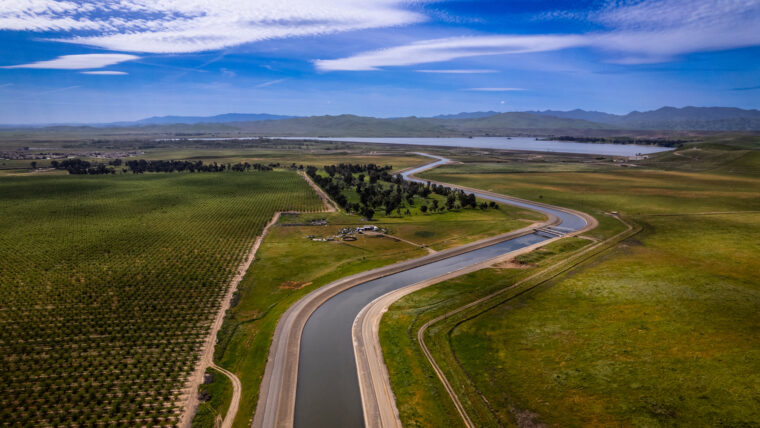
In the coming years, irrigation canals all over the United States might be significant sources of clean solar energy and be more resilient during times of drought.
Last week, the U.S. Department of Interior sent $19 million to test projects in California, Oregon and Utah that will place solar panels over irrigation canals.
Utilities conducting these test studies expect the solar panels to reduce water evaporation from irrigation canals and be a source of clean solar energy.
The projects could be replicated on a larger scale across the country if they demonstrate significant improvements in water efficiency and clean energy production.
The utilities are taking advantage of a provision under the Inflation Reduction Act that provides a pool of $25 million that organizations can tap to design, study and implement solar-powered reclamation-related water conveyance facilities.
“We look forward to working collaboratively on this novel idea to conserve water and generate renewable energy,” Bureau of Reclamation Commissioner Camille Calimlim Touton said. “These projects will help inform similar projects to better understand their impacts and make that information publicly available so that we can all understand the scale and corresponding benefits they provide.”
Installing solar panels in irrigation canals can provide a variety of benefits, including renewable energy generation and reducing evaporation losses in canals, the agency said.
The goal is to increase efficient energy production from solar panels, along with cooling the water in the irrigation canals, which results in less water evaporation.
With panels on the water, land can be saved for open space and agricultural use, and irrigation canal maintenance can be reduced with less algae and aquatic plant growth that comes with cooler water. The projects will have a smaller energy footprint and lower carbon emissions required to operate and maintain these facilities, according to Interior.
The San Luis and Delta-Mendota Water Authority was awarded $15 million for the Delta-Mendota Canal Floating Solar Project in California. The authority will work with the University of California-Merced in a public-private-academic partnership to determine the impacts of floating photovoltaic solar panels on the Delta-Mendota Canal.
The pilot project, which will last five years, will deploy up to three floating panels on the canal. The initiative aims to validate floating solar panels designed for moving water, identify and address issues related to maintaining a canal with panels on it, explore their power generation potential and develop methods to quantify impacts on the canal’s water quality.
Private partners of the pilot study will assess the efficiency of floating the solar panel prototypes, Scott Petersen, water policy director with the San Luis and Delta-Mendota Water Authority, told Government Market News.
“All partners are not identified, as one of the first phases of the project is site selection and technology selection, which iterate off of each other based on commercially available floating solar prototypes,” Petersen said.
The authority’s pilot study was selected for funding because it is in Central California, which is severely impacted by a lack of water supply reliability, Petersen said.
With the cost of moving water from irrigation canals to farmland increasing over time, reducing the energy to move that water is an important consideration for water supply affordability for the authority’s member agencies, communities, farms and ecosystems, Petersen added.
The study’s success ultimately hinges on findings that show how it can be replicated at scale, Peterson said.
“There are floating solar installations in reservoirs in a few places globally, but we are not aware of floating solar deployments in canal systems,” Petersen said. “The project will be a success if we’re able to gather sufficient data to inform the scaling potential of these technologies.”
In Oregon, the North Unit Irrigation District received $2.55 million for its Main Canal Floating Photovoltaics Project. The North Unit Irrigation District will construct floating photovoltaic solar panels on the Main Canal of the Deschutes Project. The project will evaluate the impact of floating solar panels on water efficiency gains and the amount of clean energy produced.
In Utah, the Weber Basin Water Conservancy District was given to put solar panels over the Layton Canal. The district will cover existing canals with canal-spanning solar panel structures in the upper portion of the Layton Canal. The project will serve as a five-year demonstration of data collection and monitoring to evaluate the technical capability, economic feasibility and viability for large-scale implementation for other water reclamation projects and the district. The district expects the project to increase the canal’s water quality by reducing algal blooms along the canal, produce enough renewable energy to offset the pump station’s use or sell back to the utility and significantly reduce water loss to evaporation.
Interior’s funding builds on the $5.65 million the agency sent to Arizona’s Gila River Indian Community in December 2023 to construct and install solar panels over the Casa Blanca Canal.
The Bipartisan Infrastructure Law, which was passed in 2021 also has water reclamation project funding. The legislation set aside $8.3 billion over five years for water infrastructure projects, including rural water, water storage, conservation and conveyance, nature-based solutions, dam safety, water purification and reuse, and desalination. So far, the law has allocated nearly $3 billion for 425 projects.
Photo courtesy of the Bureau of Reclamation
The post Pilot project to test placing solar panels over irrigation canals appeared first on Government Market News.
